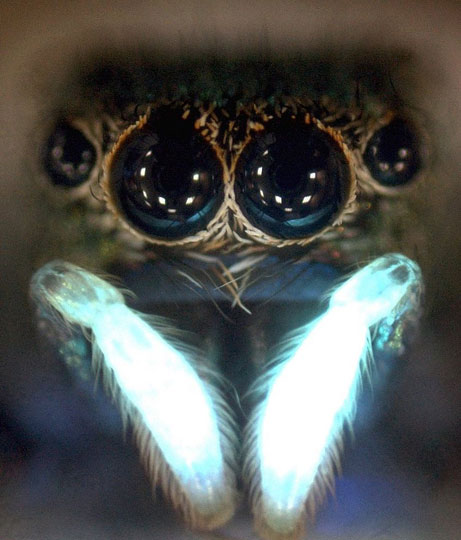Some of you know that I am afraid of spiders, but in spite of this phobia, I am nonetheless fascinated by jumping spiders because they have interesting behaviors and a superb visual system. In addition to having excellent vision, it turns out that jumping spiders are particularly sensitive to green and ultraviolet light, according to a new study that was published this past week. Using a variety of light conditions, researchers revealed that these animals evolved their sensitivities to these wavelengths because both ultraviolet reflectance and fluorescence are crucial to their successful courtship and mating.
Even more interesting is that these signals are gender specific, write researchers in the most recent edition of the top-tier peer-reviewed journal Science.
It turns out that male jumping spiders reflect ultraviolet light from patches of scales on their faces and bodies that are displayed during courtship. When in the presence of ultraviolet light, females then give off green fluorescent light from their palps, which are small appendages close to their faces.
"But we discovered UV-induced fluorescence communication in jumping spiders by chance," Li said.
Only one other animal has been known to use fluorescence as a possible courtship signal -- the budgerigar, a type of parrot, said Daiqin Li, lead investigator of the study. "But the effect merely boosted to a limited degree the brightness of the [bird's] yellow body color, and its behavioral relevance has been questioned."
"We were hoping to find out whether jumping spiders could really detect UV and respond to it, as well as whether jumping spiders use UV signals in their communications," Li explained.
Li and his colleagues studied the spiders under a variety of light conditions and recorded their behavior;
Under full-spectrum light, including UV, males and females began courtship rituals such as bent legs and hunched or flexed abdomens. Without UV light, females turned away and males ignored the females or reduced their actions. When males were placed in UV light and females were not, the females could see the reflection from the males and performed their normal courting behavior. But 16 of 20 males ignored the females, who were not reflecting UV light. And when females were in UV light and males were not, the males responded to the glowing females and began courting behavior, but 10 of the 12 females failed to respond.
"We conclude that sexual coloration is a crucial prerequisite for courtship," Li and his co-authors wrote.
Li speculates that the behavior may have evolved as a way for the spiders to signal their suitability as mates while minimizing unwanted attraction from predators. But it's still dangerous, since many spider predators, such as some birds, can see UV light.
"Both UV and UV-induced fluorescence may be costly," he said, "and thereby [may be] honest indicators of individual sex quality."
.
Cited story (quotes).
Cited story (quotes).


I'm generally not fond of spiders (I'm not afraid of them, but I do think they're kind of creepy and yucky), but I think jumping spiders are amazingly cool. I'm not sure why -- maybe it's because they hunt rather than capturing prey and allowing it to dangle for all to see -- but something about the way they move and their general appearance just makes them seem non-spider like.
(To be fair, other spiders are also pretty interesting, but I prefer to see them on the other side of a window rather than in my house!)
spiders - proof that not all furry things are not cute.
.
(I love spiders)
I'm a bit of an arachnophobe too, but I find spiders fascinating nonetheless.
There's a film clip of the UV mating ritual, but I can't find a downloadable version anywhere.